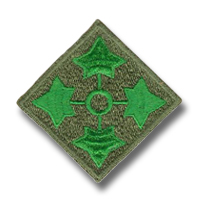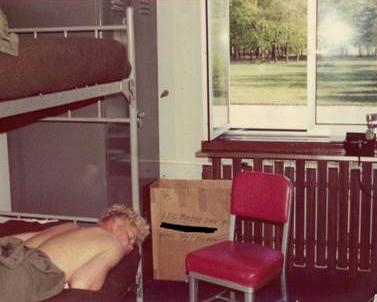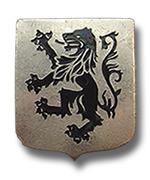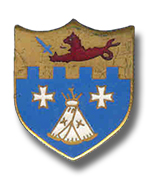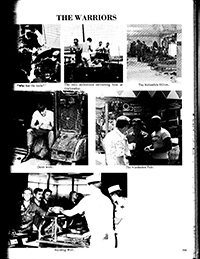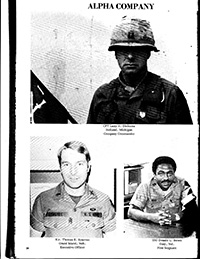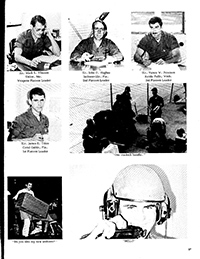| If you do NOT see the Table of Contents frame to the left of this page, then Click here to open 'USArmyGermany' frameset |
|||||||||||||||||||||||||||||||||||||||||||||||||||
4th
Brigade, 4th Infantry Division |
|||||||||||||||||||||||||||||||||||||||||||||||||||
|
|
|||||||||||||||||||||||||||||||||||||||||||||||||||
|
|||||||||||||||||||||||||||||||||||||||||||||||||||
|
|
|||||||||||||||||||||||||||||||||||||||||||||||||||
|
|||||||||||||||||||||||||||||||||||||||||||||||||||
| Brigade 76 / 4th Brigade, 4th Inf Div | |||||||||||||||||||||||||||||||||||||||||||||||||||
| (Source: Department of the Army Historical Summary, FY 1976 - www.history.army.mil accessed August 5, 2017) | |||||||||||||||||||||||||||||||||||||||||||||||||||
| The Army's major move in 1976 in increasing its combat strength in Europe involved the deployment of a reinforced brigade (Brigade 76) to Germany between March and June 1976. The headquarters and all units of the force, except for one mechanized infantry battalion from the 1st Infantry Division at Fort Riley, Kansas, and two non-divisional field artillery battalions from Fort Sill, Oklahoma, were from the 4th Brigade of the 4th Infantry Division (Mechanized), stationed at Fort Carson, Colorado. The brigade headquarters and support battalion moved to Germany in a permanent change of station (PCS) status and the remainder of the force on a temporary duty (TDY) basis. It was the intent of the Army to return the TDY units to the United States after six months, replace them with other TDY units for the next six months, and continue the rotation indefinitely. But, in May 1976, Army Chief of Staff General Fred C. Weyand decided to convert most of the force to PCS status at the time of the next rotation in October 1976. General Weyand made this decision because of an adverse effect on parent units in the United States in sustaining the rotation and because family separations caused by TDY for extended periods were damaging morale. As a result, the next replacement units were to deploy with 84 percent of their members in a PCS status; persons deploying on temporary duty were to be replaced at the end of their tours through the normal individual replacement system. |
|||||||||||||||||||||||||||||||||||||||||||||||||||
| FIRST INCREMENT UNITS - "BDE 76/I" ORGANIZATION (1976): | |||||||||||||||||||||||||||||||||||||||||||||||||||
|
|||||||||||||||||||||||||||||||||||||||||||||||||||
| If your unit was in the 1st Increment (Bde 76/I) and is not listed, please contact the webmaster | |||||||||||||||||||||||||||||||||||||||||||||||||||
| SECOND INCREMENT UNITS - "BDE 76/II" ORGANIZATION (1976/77): | |||||||||||||||||||||||||||||||||||||||||||||||||||
|
|||||||||||||||||||||||||||||||||||||||||||||||||||
| If you PCS'ed to Germany with one of the second increment units, I (webmaster) would like to hear from you | |||||||||||||||||||||||||||||||||||||||||||||||||||
| 1976 | |||||||||||||||||||||||||||||||||||||||||||||||||||
| (Source: Email from Robert L. Stephenson) | |||||||||||||||||||||||||||||||||||||||||||||||||||
| I was assigned to the Company E 704th Maintenance Battalion at Fort Carson Colorado in the spring of 1975.
Sometime that fall there was an informal call for volunteers to go on a six month TDY to Germany for Brigade 76. I interviewed with 1st Sergeant Richard Skolnekovich and Company Commander whose name escapes me. Within a week I was assigned to HHC 4th Brigade 4th Infantry Division as the only 52B (= Power Generation Equipment Operator/Mechanic. It was later combined with 63B/C) We packed and prepared that winter and early spring for deployment to Wiesbaden Air Base, FRG, as HHC 4th Brigade 4th Infantry Division (Forward) In late March we departed Fort Carson on a 727 and flew to Chicago O’Hare airport. After what seemed to be an all-day layover we boarded a Lufthansa 747 and flew nonstop to Frankfurt. Ground Transportation to Kaiserslautern Army Depot was provided by tourist type busses. We slept on standard issue cots and had K-Rats the first night our first night in Germany. The next morning we picked up our brand new wheeled vehicles and departed for Wiesbaden Air Base in a harrowing convoy thru streets barely wide enough to drive a Volkswagen let alone the 5 ton cargo I was assigned to drive. I know for a fact I left paint from both mirrors on local buildings. HHC 4th Brigade 4th Infantry Division (Forward) was barracks on the 2nd floor. The first floor contained our staff offices and the base's Class VI store. The entire base's female quarters were on the 3rd floor above us and we protected them like we would our sisters. My duty area was shared with the British Air Force weather guys. They had a grand old time making fun of my Texas accent but we became good friends. They drank heavily and would come in late most days but they did seem to be able to throw darts with extreme precision. This was a great beginning to a six month TDY deployment that would end up as a 3 year permanent duty station for me. The information is just flowing as I remember so many details of some great years of my life. |
|||||||||||||||||||||||||||||||||||||||||||||||||||
| (Source: Email from Mike Dean) | |||||||||||||||||||||||||||||||||||||||||||||||||||
| I was assigned to the Combat Support Company, 1st Bn, 12th Infantry Regt, 4th Inf. Div. in June 1975. I was in the Tank Killer Platoon and we were the first CONUS unit to receive the TOW after years of employment by the Israeli Forces. We went through rigorous training and qualifications on the TOW as well as tactics and maneuvers to be assigned as 11H. I was the first to qualify Expert In my unit and was assigned as Section Leader. We also were one of the first wave to deploy to Wiesbaden, which was a converted Luftwaffe Air Base which had been mothballed since the end of WWII. Our barracks also were above the Orderly Room and Admin offices. I also remember the Brigade Mess Hall was a converted Hanger. The KPs were mostly Turkish civilians not GIs. During our time there I remember when the grandfather of the present North Korean Dictator started some trouble, threatening invasion of the South. We were immediately on Alert and sat on the airfield for quite some time, combat ready to deploy until he finally stood down. Soon after, our company was deployed to the East German border. We had our TOWs forward of the company with Ground Surveillance Radar, the Scout Platoon beside us and the Red Eye Platoon (heat seeking missiles). The East Germans (and Russians) were directly across from us with several hundred T-71, T-72 tanks in plain view ready to come across at any time if the ballon went up. The Border had a fence well over 12 ft high with multiple strands of barb wire, as well as directional mines positioned on the fence to blow along the fence if any motion or vibration was sensed. All night long we could hear the mines go off, mostly from wildlife getting too close to the fence but also when East Germans desperate to escape triggered the mines. The Germans in the little villages along the border were very grateful for us being there and would line the streets as we convoyed through the village waving and sometimes throwing flowers in the street. Once a little girl tried to cross in front of one of our Tracked Vehicles and was run over before the TC could get it stopped. We were all pretty shook up over that for quite some time. Next, we were sent to Grafenwoer for the first NATO combined forces training exercise since WWII. As I recall, it lasted at least 30 days and was during a 100-year drought they said and the dust was very deep. Every night we set up in battle positions and I always had my men sleep close to the Tracks for safety. One night a Howitzer came through without lights past our camp and just down the line accidentally ran over a soldier in his sleeping bag. He was so badly mangled they just transported him in his mummy bag. |
|||||||||||||||||||||||||||||||||||||||||||||||||||
| (Source: Email from Dan Murphy) | |||||||||||||||||||||||||||||||||||||||||||||||||||
| I was part of the early Brigade 76 deployment from Ft. Carson, (approximately May thru October). My unit was A Co., 1st Bn 77th Armor Regt, 4th infantry Division (Mechanized). And Wiesbaden Air Base, (WAB) as it was called at that time, became the permanent duty station for my unit. I can’t remember where we landed in Germany, (possibly Ramstein) but it was near Kaiserslautern, or K-town as we referred to it, and that was where we loaded our tanks and other vehicles on rail flat cars for shipment to WAB. I was 19 years old at the time, an E-4 and primarily a 63C20 tracked vehicle mechanic and secondarily a 11E10 tank crewman. I also operated the company M88 VTR, (gas) and that was a lot of fun for a young guy who liked cool machines. We spent quite a bit of our tour in Grafenwöhr, Germany that summer practicing tank gunnery. Located about 20 miles west of the Czechoslovakia border and at that time part of the Iron Curtain. We spent more time putting out the fires produced by our main gun rounds than we practiced tank gunnery. I didn’t fathom the danger of my location at that time as I was young and I didn’t grasp the reality of the tension between the East and West at that moment in history. I found the German people very hospitable and enjoyed drinking their potent beer. (I killed a lot of brain cells over there). I returned to Ft Carson in November 1976 and ETS’d the following march. One thing I’ll never forget is the WWII bullet marks on the outside barrack’s walls (looks all patched up now) at WAB! Those and all the other left over WWII relics drove home the stark reality of our involvement in the war and I can’t say enough about those men and women who served back then. Whenever I speak with a young veteran, active or inactive, I’m always impressed by how respectful they are compared to the rest of society. They are our best and deserve our support! Wish I would have traveled more while over there but we spent so much time on the range that there was little left for travel and before you knew it we were coming home. |
|||||||||||||||||||||||||||||||||||||||||||||||||||
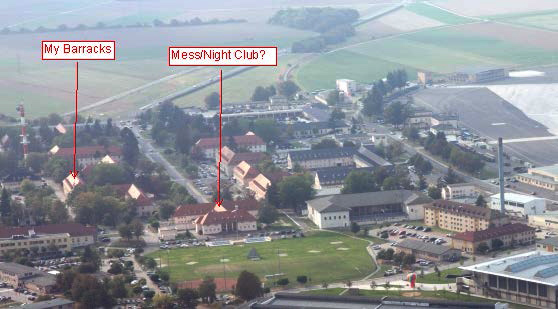 Wiesbaden Air Base |
|||||||||||||||||||||||||||||||||||||||||||||||||||
|
|||||||||||||||||||||||||||||||||||||||||||||||||||
| (Source: Email from Anthony Cahill) | |||||||||||||||||||||||||||||||||||||||||||||||||||
| You are missing the 28th INF REG. I was with 3/28th INF "Black Lions" at Fort Riley, KS when we deployed to Germany in November 1976 as part of 4th DIV Forward. We were at Wiesbaden AB along with other units. I was an E-4 at the time so most of the details are that of an E-4. At Fort Riley I was transferred from one unit to 1/28 IN in the summer of 1976. We then cased the 1/28 INF colors and became 3/28 INF in preparation for BDE 76, 4 ID (Forward) in November 1976, The Brigade was associated with 8 ID in some manner (Direct Support?/General Support?). We occupied Wiesbaden AB after the Air Force was relocated elsewhere (Webmaster note: CREEK SWAP.). The only other units that I can remember are 1/4 CAV and the 2/22 IN. There was a BDE HQ, Arty, and Armor units on the AB with us. (Webmaster note: I believe 3rd Bn, 28th Inf replaced 1st Bn, 18th Inf that had been part of the original deployment early 1976.) |
|||||||||||||||||||||||||||||||||||||||||||||||||||
 4th Bde area, Wiesbaden Air Base (Bob Henninger) |
|||||||||||||||||||||||||||||||||||||||||||||||||||
 Ammo dump at Wiesbaden Air Base (Bob Henninger) |
|||||||||||||||||||||||||||||||||||||||||||||||||||
| (Source: Email from Bob Henninger, Advance Party, 3rd Bn, 28th Inf, 1976-77) | |||||||||||||||||||||||||||||||||||||||||||||||||||
|
|||||||||||||||||||||||||||||||||||||||||||||||||||
| I was asked to reenlist or extend to jump with the German balloon jumpers. I declined and took leave in conjunction with ETS. Do you know if Brigade 76 was initiated because an Iranian terrorist was threatening (General) Colin Powell? That's what I have heard back in 1976! I found out on German FB groups that 3/28 was deactivated and the remaining solders assigned elsewhere. |
|||||||||||||||||||||||||||||||||||||||||||||||||||
| (Source: Email from Lynn Williams, 2/20FA, 1976-79) | |||||||||||||||||||||||||||||||||||||||||||||||||||
| My old unit was 2/20FA, 4th Bde, 4th INF Div. I was assigned to the 8ID from 76-79. The entire brigade (Bde 76) was encapsulated on the Wiesbaden Airfield. On the runway there was a hard stand for our armor and ammunitions, and there were barracks and billeting there also. We shared this small airfield and kaserne with the US Air Force because it primarily belonged to them. However we had access to the autobahn and to railroad access on post, so that in an emergency we could depart by road or load immediately to troop and flatcar train and depart. Or we could clear the runway and depart by MAC. The only other places that were available to us, were the nearby Hainerberg Shopping Center, Wiesbaden Hospital, Amelia Earhart Hotel, and Lindsay Air Station PX. A kaserne @ Mainz-Kastel or up the highway to the large Army Facility in Frankfurt. We actually spent more time training in the field, 24/7, than we did on post. Very little garrison time. It seemed that we were always going on alert. One thing I do remember , which I am sure is no longer classified is that we did carry Nuclear Tac. Also with our Nac clearances they would never let us visit Berlin. In other words don't ask to go because we will just turn you down, however you can visit any other place you would like in Western Europe. I don't know but I imagine that area would be like a ghost town on that airbase now and possibly abandoned. That's been more than 25 years ago, and the Cold War is over. Also, if I remember correctly, we had in addition to our artillery battalion, 2 armor & 2 infantry battalions at the same location (something like the 68th or 69th Armor and 2/16 Infantry or 2/22 Infantry). The 8th Aviation Battalion and 8th ID Headquarters were at Bad Kreuznach. A huge Supply Depot was located inside a mountain @ Idar Oberstein. I attended the 8th ID NCO Academy @ Baumholder, which was really more of an infantry NCO Academy, those instructors liked to have killed us artillery guys. It made basic training feel like a cake walk. It was the roughest training in those mountains down there I have ever experienced in my life. Lynn Williams |
|||||||||||||||||||||||||||||||||||||||||||||||||||
| (Source: COLORADO SPRINGS GAZETTE, June 4, 1976) | |||||||||||||||||||||||||||||||||||||||||||||||||||
| The second rotation scheduled to leave for Germany in October 1976, will comprise approximately 2,200 officers and enlisted personnel. They will be assigned to replace those in infantry, artillery and armored battalions, the engineer company and cavalry troop currently stationed with Brigade 76 in Germany. The troops will be deployed in several incrememts - with the first increment leaving in early October and the final one by the end of October. Since the Brigade will convert to PCS status, dependents will be allowed to accompany the troops to Germany. |
|||||||||||||||||||||||||||||||||||||||||||||||||||
| (Source: Email from Ray Routhier, 1st Bn, 12th Ing) | |||||||||||||||||||||||||||||||||||||||||||||||||||
|
|||||||||||||||||||||||||||||||||||||||||||||||||||
| I remember the barracks we were assigned were above the office of the base commander so we had to be careful about noise. Looking at an installation map for WAB and an old yearbook that we had, I recognize some things. I believe our barracks were just inside the main gate on the right hand side. I recognize the baseball field. Also I remember that an airplane hangar was converted into a large mess hall. I think that was building 52. I spent a lot of time in the bowling alley and at the movie theatre (called Flyers Hall in my yearbook). I also went to the NYMBUS club at least once a week, which I think must have been the enlisted men's club since I was not yet an NCO. The yearbook I have focused on our unit and did not mention other (BDE 76) units that were there with us. |
|||||||||||||||||||||||||||||||||||||||||||||||||||
| (Source: Email from Jim Trice, 1st Bn, 12th Inf, Bde 76) | |||||||||||||||||||||||||||||||||||||||||||||||||||
| I served the 6 months as the I was the 1st Mech Platoon Leader in A Co, 1/12th Inf during Brigade 76. (Walter, I was there for 5 months and 21 days. About the longest one can be on TDY and collect the extra bit of TDY pay. I guess the times I was in country to be Feb 76 to July 76.) This Battalion was perhaps the best mech unit of its size in the Army at that time. The best of the best from Ft. Carson to include LTC Neely, the Battalion CO. The 1/12th I remember had awesome Co Commanders (in particular a CPT Dillon– B Co CO – was world class) but more impressive were the 1SG’s of all the companies. They were some of the best I ever served with to include as a SF Team Leader in the 7th SFG. (As soon as we got back from Germany, I was lucking enough to get assigned as Special Forces SFOD A 752 at Bragg.) Also, FYI, the entire Scout Platoon had the chance to attend French Commando School (1LT Mayes had the honor of leading that unit), and the platoon leader officers had wonderful quarters downtown – American Arms (private room with a single bed and shared bath with just one fellow officer, when not in field, which we were most all of the time. Broke many a BECK beer bottle in the bar at the hotel letting off steam. Great food there too. I don’t remember much about the location of things on the base (Wiesbaden Air base) at all. Seems like most of my memories were about training and just having fun as a young gung ho Army Infantry officer and kid, in a very serious Cold War environment. Yet I remember being truly concerned about all the T72’s and stuff rolling over the top of us. This was a post Viet Nam era that no one cared about. We were paid jack chit and no one in the USA gave a chit about the Army at this time. It was the very beginning of the All-Volunteer Army. Some in today's Army complain and feel entitled. They are treated and paid like Saints compared to this time in our nation’s history. Certainly glad we were not in a War, but we worked our asses off too. A few pages from the Yearbook are attached below. |
|||||||||||||||||||||||||||||||||||||||||||||||||||
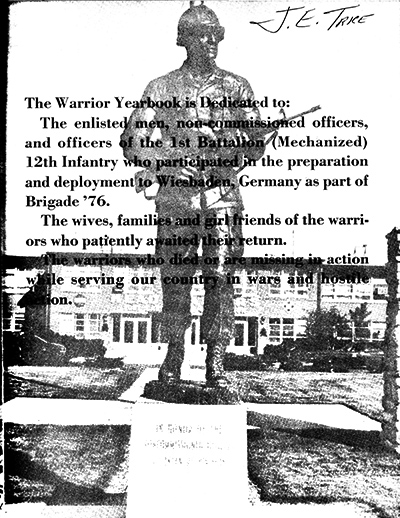 1/12th INF Brigade 76 Yearbook |
|||||||||||||||||||||||||||||||||||||||||||||||||||
| (Source: Email from Jim Eager) | |||||||||||||||||||||||||||||||||||||||||||||||||||
For 4th Brigade, 4th Infantry Division (Fwd) units you can add:
|
|||||||||||||||||||||||||||||||||||||||||||||||||||
| (Source: Email from Mike Brewer) | |||||||||||||||||||||||||||||||||||||||||||||||||||
| I was a member of 2nd Battalion, 22nd Infantry when it did the Unit Change of Station to Wiesbaden, Germany in 1976. Some of what I remember I joined what was then Company B, 1/22 Infantry, 4th Infantry Division at Fort Carson, Colorado as part of my Station of Choice enlistment option in April, 1975. The unit was at that time located in the old "Mule Barn" section of Ft. Carson, WWII-era wooden two-story barracks which housed a few other battalions as well. One was the 1/12 Infantry Batallion. The Station of Choice option guaranteed me sixteen months at Ft. Carson. At the time of my enlistment, a four-year enlistment into a combat arms MOS came with a $2,500 enlistment bonus, which I collected. In the spring of 1976 the 1/22 was moved into new construction barracks elsewhere on post. They were set up as two-man dormitory-style rooms. Around that same time, we were informed that we would be doing a six-month TDY rotation to Wiesbaden, Germany that fall as the second part of Brigade 76. In conjunction with the move, we were re-designated 2/22 Infantry Bn., and the 1/12 became the 1/22. A woman I knew who was connected with base personnel told me that we were being deliberately misled, and that the transfer was going to be a PCS move, not a six-month TDY assignment like the first units sent to Wiesbaden. A few months later, her information was proven to be correct, when we were told that it was indeed a PCS. NCOs and officers would be allowed to do a 36/39 month accompanied tour with dependents, while lower-ranking enlisted men would be doing a 24-month unaccompanied assignment. As a single SP/4 at the time, it was two years for me. As part of our preparations for deployment to Germany, we received a 40-hour Headstart program on German language and culture, taught by a native German military wife contracted by the Army. I found it to be quite helpful. On October 23, 1976 my company was bussed over to Peterson Field where we boarded chartered aircraft. We landed in Detroit, Michigan for re-fueling, and then continued to Frankfurt Airport. From there, we were bussed to our awaiting quarters at Wiesbaden Air Base. I was an 11C assigned to Weapons Platoon. While in Germany, the platoon consisted of both 81mm mortar and TOW anti-tank missile crews. Both platforms were carried in modified M-113 Personnel Carriers. Both could also be ground-mounted. Bravo Company's commander during my entire time in Germany was Catain Joseph Lazer. Our First Sergeant was 1SG (later CSM) Sidney Raspberry, now deceased. The Weapons Platoon sergeant was SFC Paul Nadeau, also deceased. Our platoon leader was 1LT Donald Harris. Some of the other members of our platoon that I remember were Ronald Fisk, Michael Doyle, Mark Toellner, Steve Ott, Michael Bartz, Oscar King, Luis Alberto (Albert) Matos, Jerry Doyle, Andrew McCoy, Wilbert Maxwell, Marvin "Shaky" Goodhue, and my roommate, Richard Anthony Herzog, also deceased. All the units of Brigade 76 spent about half the time in the field, as I recall. It wasn't unusual for us to go out for two or three weeks, return for a week or so, and then go right back out. Wildflecken, Hohenfels, Grafenwoehr, Baumholder, and Fulda were all regular training destinations for us. | Our equipment was often loaded onto trains there at the base and then transported to our training destination. In August of 1976 I reenlisted, and left Germany in December. Wiesbaden Air Base Looking at the map and a modern GoogleEarth image, I recall that Bravo Co. of the 2/22 Infantry was housed on the second floor of Building 7. I'm not certain, but I believe A and C companies were below and above. I'm fairly certain Building 8 was battalion HQ. I believe Bldg. 43 was the EM Club; #42 the PX and Snack Bar/cafeteria, and #40 the bowling alley. I'm thinking #43A was the Class VI store. I think #29 was the education center and arts/crafts facility. Big Bend Community College of Moses Lake, Washington had a satellite facility in the education center and offered a high school completion program, complete with high school diploma upon successful completion. Even though I had my GED prior to enlistment, my unit encouraged me to enroll and receive a regular high school diploma, which I did. Our motor pool was on the tarmac area south of the runway. I don't recall exactly where. Hope my forty-plus years recollection helps some. |
|||||||||||||||||||||||||||||||||||||||||||||||||||
| 1977 | |||||||||||||||||||||||||||||||||||||||||||||||||||
| (Source: STARS & STRIPES, Nov 19, 1977) | |||||||||||||||||||||||||||||||||||||||||||||||||||
| Brigade 76 marked its 1st anniversary as a permanently based unit in Germany with a static display of weapons, a parade and review of troops at Wiesbaden Air Base. (Webmaster note: Brigade 76 was originally deployed on a TDY basis - the plan was for brigade units to rotate on a six-month basis with other like units in the States. After completion of the first six-month rotation, the Brigade became a PCS unit in November, 1976.) Under the PCS concept, single troops and those accompanied by their dependents served a regular tour in USAREUR of 39 months, and married unaccompanied troops, 27 months. The Brigade comprises about 3,600 military personnel assigned to eight different units. |
|||||||||||||||||||||||||||||||||||||||||||||||||||
| (Source: Email from Ray "KC" Donez, F Co, 4th Engr Bn, 1977-79 ) | |||||||||||||||||||||||||||||||||||||||||||||||||||
I was stationed at what was then called Wiesbaden Air Base in 1977-79. "F" Company, 4th Engr. Bn (had just the one co.) deployed during Brigade 76 and participated in REFORGER 76 excercises etc. I was deployed in 1977 as a replacement.
The 4th was based in Carson, CO. It deployed, as I mentioned, as a participant in a REFORGER X in 1976. I cannot recall the CO's name who was commanding at the time of my arrival (May 77'), but if I think long enough... Eventually, command was assumed by Capt. James V. Mudd. Our Company ( F) was an oddity, I believe, as it was only us stationed at (then called) Wiesbaden Air Base. (There were No additional Combat Engineer Companies, i.e., A, B, C, etc. There were POST Engineers, but obviously they had a different initial task, etc. We had three platoons, if I recall. Maybe 6-7 APC's, a CEV, 1 or 2 deuce and a halfs, a Gamma Goat, and I recall a 5-ton and a dozer being available, but cannot recall if they were stored in our company's Motor Pool area. I don't believe they were, at least not on a regular basis due to space available. That's about it for equipment. We did the usual while there . . . various training, which I won't go into here, except to say that it was pretty routine. The two exceptions were a 4-5 day FTX on the Rhine in assault boats (we actually got some freighters to tow us...BIG ships...little assault boats...can you say WET!?...but that's another story...) We also did an Air (Huey's) deployment into the mountains, with the goal of Land-Nav back to a pick up point, which if I recall lasted maybe 2- 3 days if that, including the jump off. Some of the guys built a playground in a village...can't recall where, but I recall the "thank you " party....sort of... LOL. So... I have had very limited success with finding any record of F/4/E on the web... I think the unit proper was deactivated in the 1980's, your best bet is (former) Captain Mudd, as well as Military. Com. which lists several past members of 4th Engr's, some of which "show" as having been at Wiesbaden in the early to mid 1980's. |
|||||||||||||||||||||||||||||||||||||||||||||||||||
| 1981 | |||||||||||||||||||||||||||||||||||||||||||||||||||
| (Source: Email from Wade Dehaven) | |||||||||||||||||||||||||||||||||||||||||||||||||||
| My stay at F Company, 4th Engr Bn, was sweet and sour. Sour was when in work detail of course, but I loved the field. I applied myself as often as allowed. My first day at HQ a Jeep arrived and took two of us to our barracks. We turned over our orders to the man at the desk and waited. Suddenly two good looking female E4's came out. Wow! This might not be so bad, only a mistake was made and we drove back to HQ and 30 minutes later our escort arrived and we carried our gear to the far corner of the base to all male barracks. My first interview with command I asked about getting my driver's license and it left me with the impression I was offering them each a new car. As it turned out no one wanted to drive. I took drafting and shop management, but field duty with the officers stopped any more college. Many trips to the Gap and training bases allowed me see Germany and enjoy the food. One big plus is all the toys we could play with free. Explosives, guns, laser tag, mine detectors, tank trails and the machines to drive on them. I really liked the indoor firing range which trained in calling in artillery and mortor fire or M16 firing. When your work was done just ask and most often you were free to play the military toys. The others in the motor pool got to do something less fun like police call. Most in my unit worked hard at not training or as little as possible. My plan is to get the knowledge to live threw war. Our unit caught a 2-star Russian general with SMLM #3. The first legal catch in two years and first time #3 was caught in 1981 or 1982. Our 2-star general landed his helocopter on the autobahn and German police were not happy we closed the roadway for hours waiting for the MPs. Our general was very happy to wait. |
|||||||||||||||||||||||||||||||||||||||||||||||||||
| 1983 | |||||||||||||||||||||||||||||||||||||||||||||||||||
| (Source: STARS & STRIPES, June 18 1983) | |||||||||||||||||||||||||||||||||||||||||||||||||||
| The US Army has announced that the 4th Brigade, 4th Inf Div at Wiesbaden will be deactivated as part of the "Division 86" implementation in USAREUR. Most of the brigade's equipment and troops will be distributed among the four divisions in Europe. The deactivation process is scheduled to start in April 1984. There are about 3,500 people in the brigade. Due to mandated force levels in Europe, the US cannot send additional troops to Europe. The inactivation of the brigade gives USAREUR the means to convert the command's four divisions under Division 86 and increase their peacetime manning levels. |
|||||||||||||||||||||||||||||||||||||||||||||||||||
| (Source: Email from David O'Brien) | |||||||||||||||||||||||||||||||||||||||||||||||||||
| I hope I can contribute to the documentation of this history before it’s gone for good. Change was pretty constant in the Army over the years so that greatly complicates the task. I was stationed in Wiesbaden with Company A, 3rd Battalion, 28th Infantry (“Black Lions ", which was part of the 4th Brigade, 4th ID between March 1983 until the unit was deactivated in July 1984. I was a 1st Lieutenant at the time of the deactivation. My company (A Company) became D Company, 2nd Battalion, 13th Infantry, and we moved to Coleman Barracks near Mannheim. I made the move with them. A short time later the 2-13 became the 4-8 Infantry. A Company was located in the building which can be found on Google Maps at 28RH+HV Wiesbaden, Germany. Battalion HQ was in the building at 28RH+GH Wiesbaden, Germany directly across the street from the PX. Bravo and Charlie Companies were in the building behind HQ. And HHC and Combat Support Company were in the barracks at 28RJ+H7 Wiesbaden, Germany. Although 4th Bde was a separate brigade, it fell under the command of the 8th ID. We trained with other battalions and brigades of the 8th ID. When I first arrived in Wiesbaden, there were no aviation units there, and the runway was unused. Eventually, some Mohawks were stationed there. The apron was a very large motor pool for the Brigade. The deactivation ceremony of the 3-28 was held on the apron. I don’t recall the exact date, but it was in the late Fall or early Winter, since I remember it being cold. I lived in the American Arms Hotel, which was a BOQ at the time. It is at 37G2+J5 Wiesbaden, Germany. I heard from a reliable source that it is no longer owned by the US Military. It was used to house Syrian refugees, but is slated to be demolished. It was a BOQ for the Luftwaffe during WW2. I should add that I met my wife of 35 years in Wiesbaden. And we got married in the Chapel on the Air Base on June 8, 1985. She worked in the American Express Bank that was in Wiesbaden Air Base in the same place that Bank of America now occupies. I have very fond memories of Wiesbaden, the people with whom I served in the Black Lions, and Germany in general. . |
|||||||||||||||||||||||||||||||||||||||||||||||||||
| 1984 | |||||||||||||||||||||||||||||||||||||||||||||||||||
| (Source: STARS & STRIPES, July 6 1984) | |||||||||||||||||||||||||||||||||||||||||||||||||||
| 4th Brigade will be inactivated on July 6, 1984 during a ceremony to be held at Wiesbaden Air Base. All battalions previously assigned to the brigade have already been inactivated, redesignated or relocated. |
|||||||||||||||||||||||||||||||||||||||||||||||||||
|
|
|||||||||||||||||||||||||||||||||||||||||||||||||||
|
Related Links: |
|||||||||||||||||||||||||||||||||||||||||||||||||||
